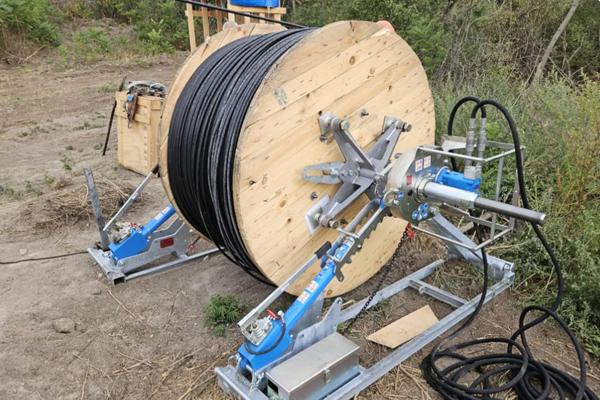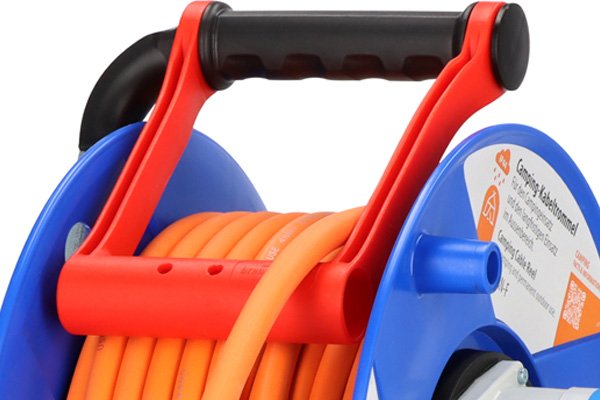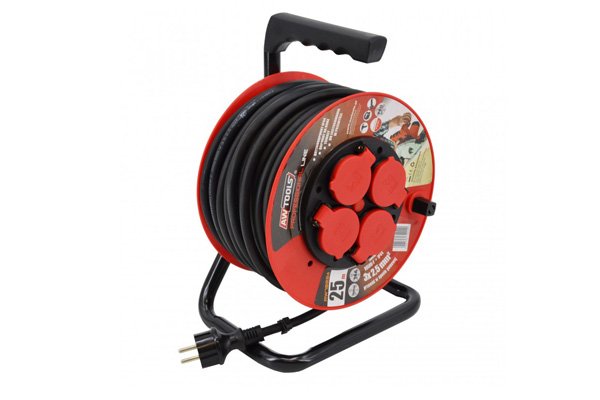
Have you ever tangled with a mess of cables, struggling to keep them organized and accessible? Cable reels might be the unsung heroes you need to bring order and efficiency to your setup.
A cable reel is a device designed to neatly store and manage cables, preventing tangles and extending their lifespan. Whether you’re setting up a home office, organizing a workshop, or managing cables in a retail environment, understanding cable reels can significantly enhance your space’s functionality and safety.
Keeping your cables organized has never been easier.
What is the purpose of a cable reel?
cable reel[^1] are essential for organizing and managing cables, ensuring they remain untangled and easily accessible.
The primary purpose of a cable reel is to store and manage cables, reducing clutter and preventing damage from tangled wires. By keeping cables organized, cable reels enhance safety, improve efficiency, and extend the lifespan of your electrical cords.
A simple tool that makes a big difference in everyday organization.

When I first started setting up my workshop, the chaos of tangled cables was overwhelming. Investing in a cable reel transformed my workspace, making it more organized and safer to work in. No more tripping over wires or struggling to find the right cable when needed.
Benefits of Using a Cable Reel
Cable reels offer numerous advantages that go beyond mere organization:
- Prevents Tangles: Keeps cables neatly coiled and untangled.
- Extends Cable Lifespan: Reduces wear and tear from constant bending and twisting.
- Enhances Safety[^2] Minimizes tripping hazards and electrical risks.
- Improves Aesthetics: Creates a clean and professional-looking environment.
- Facilitates Easy Access: Makes it simple to deploy and retract cables as needed.
Applications of Cable Reels
Cable reels are versatile and can be used in various settings:
- Home Offices: Manage power cords, computer cables, and peripherals.
- Workshops: Organize tools and equipment cables for efficiency and safety.
- Retail Stores: Keep display and lighting cables orderly and accessible.
- Event Venues: Easily deploy and retract audio-visual cables for events.
- Construction Sites: Handle heavy-duty cables safely and efficiently.
| Feature | Description |
|---|---|
| Tangle Prevention | Keeps cables neatly coiled and organized. |
| Durability | Made from robust materials to withstand wear. |
| Portability | Easy to move and transport as needed. |
| Capacity | Varies to accommodate different cable lengths. |
| Safety Features | Includes locking mechanisms and protective covers. |
How many types of cable reel?
There are several types of cable reels, each designed to cater to specific needs and applications.
Cable reels come in various types, including manual, electric, portable, and stationary models. Each type offers unique features tailored to different environments and usage scenarios, ensuring that you can find the perfect solution for your cable management needs.
Understanding the different types helps in selecting the right reel for your requirements.

Choosing the right type of cable reel was a game-changer for me. From portable reels for on-the-go tasks to stationary ones for fixed setups, each type served a distinct purpose in maintaining an organized workspace.
Types of Cable Reels
- manual[^3] Cable Reels: Operated by hand, these reels are simple and cost-effective, ideal for light-duty applications.
- Electric Cable Reels: Powered by electricity, offering automatic winding and unwinding for heavy-duty tasks.
- Portable Cable Reels: Lightweight and easy to move, perfect for temporary setups and mobile workstations.
- Stationary Cable Reels: Fixed in place, suitable for permanent installations in offices, workshops, and industrial settings.
- Motorized Cable Reels: Feature motor-driven mechanisms for effortless cable management in large-scale operations.
Choosing the Right Type
Selecting the appropriate type depends on factors like cable length, usage frequency, portability needs, and the specific environment where the reel will be used. For instance, electric and motorized reels are ideal for high-demand settings, while manual and portable reels suit smaller, less intensive tasks.
| Cable Reel Type | Ideal Use Case | Key Features |
|---|---|---|
| Manual | Light-duty applications | Hand-operated, cost-effective |
| Electric | Heavy-duty tasks | Automatic winding, higher capacity |
| Portable | Temporary setups, mobile workstations | Lightweight, easy to transport |
| Stationary | Permanent installations | Fixed in place, robust construction |
| Motorized | Large-scale operations | Motor-driven, effortless management |
Advantages of Each Type
- Manual: Affordable and easy to use without the need for power sources.
- Electric: Saves time and effort with automated functions.
- Portable: Flexible and convenient for various locations.
- Stationary: Durable and reliable for consistent use.
- Motorized: Handles large volumes of cables with ease.
What can I do with a cable reel?
Cable reels are incredibly versatile and can be used in a multitude of ways to enhance organization and efficiency.
With a cable reel, you can effectively manage electrical cords, extension cables, and other types of wiring in various settings. This not only keeps your space tidy but also protects your cables from damage and ensures easy access whenever you need them.
From home setups to industrial applications, cable reels offer practical solutions for cable management.

Implementing cable reels in my home and office settings streamlined my cable management process. Whether it was powering multiple devices in my workspace or organizing tools in the garage, cable reels made the tasks more manageable and efficient.
Practical Uses of Cable Reels
- Home Offices: Organize computer cables, power cords, and peripherals for a clean workspace.
- Workshops: Manage tool and equipment cables, preventing tripping hazards and equipment damage.
- Retail Stores: Keep display and lighting cables orderly, enhancing the store’s appearance.
- Events: Easily deploy and retract audio-visual cables for seamless event setups.
- Construction Sites: Handle heavy-duty cables safely, ensuring durability and ease of access.
Enhancing Efficiency and Safety
Cable reels not only improve the appearance of your space but also contribute to safety by reducing the risk of tripping over loose cables. They also help in prolonging the lifespan of your cables by preventing excessive bending and tangling, which can cause wear and tear.
Customizing Cable Reels for Your Needs
Many cable reels offer customization options, such as adjustable lengths, different mounting styles, and additional safety features like locking mechanisms. This allows you to tailor the reel to your specific requirements, ensuring optimal performance and convenience.
| Application | How Cable Reels Help | Benefits |
|---|---|---|
| Home Office | Organize computer and peripheral cables | Clean workspace, easy access |
| Workshop | Manage tool and equipment cables | Prevent tripping, protect tools |
| Retail Store | Keep display and lighting cables orderly | Enhanced store aesthetics, safety |
| Events | Deploy and retract AV cables efficiently | Streamlined setups, quick adjustments |
| Construction Site | Handle heavy-duty cables safely | Durable, easy access, reduced wear |
Maximizing Cable Reel Benefits
To fully leverage the advantages of cable reels, consider factors like cable type, usage frequency, and environmental conditions. For example, outdoor cable reels should be weather-resistant, while those used in high-traffic areas should be durable and secure.
How to choice a cable reel when I want to buy?
Selecting the right cable reel involves evaluating your specific needs and understanding the features that best suit your usage scenarios.
Choosing the correct cable reel requires considering factors such as cable length, load capacity, portability, and the environment where it will be used. By assessing these aspects, you can select a cable reel that not only meets your organizational needs but also ensures safety and durability.
Making an informed choice ensures that your investment in a cable reel pays off in enhanced efficiency and longevity of your cables.

When I decided to upgrade my cable management system, I focused on identifying my primary needs. Whether it was the length of cables, the frequency of use, or the specific environment, understanding these factors helped me choose the perfect cable reel that seamlessly integrated into my workflow.
Factors to Consider When Choosing a Cable Reel
- Cable Length and Diameter: Ensure the reel can accommodate the length and thickness of your cables.
- Load Capacity: Check the maximum weight the reel can handle, especially for heavy-duty applications.
- Portability: Decide if you need a portable reel for on-the-go use or a stationary one for fixed setups.
- Mounting Options: Choose between wall-mounted, floor-standing, or freestanding reels based on your space.
- Durability and Material: Opt for high-quality materials that can withstand regular use and environmental factors.
- Safety Features: Look for features like locking mechanisms, surge protection, and child safety shutters if needed.
- Ease of Use: Consider how easy it is to wind and unwind cables, especially for frequent adjustments.
Evaluating Your Needs
Start by assessing the specific requirements of your environment and the types of cables you need to manage. For instance, a workshop may require a heavy-duty, floor-standing reel, while a home office might benefit from a compact, wall-mounted option.
Comparing Features and Specifications
Create a comparison chart to evaluate different cable reels based on their features and how they align with your needs. This helps in making an informed decision and selecting a reel that offers the best value for your investment.
| Feature | Importance | How to Evaluate |
|---|---|---|
| Cable Capacity | Ensures the reel can handle your cable size | Check manufacturer specifications |
| Portability | Necessary for mobile setups | Look for lightweight and easy-to-move designs |
| Mounting Options | Fits your workspace layout | Choose based on available space and usage |
| Durability | Long-lasting performance | Opt for high-quality materials and construction |
| Safety Features | Protects against electrical hazards | Look for built-in surge protection, locking mechanisms |
| Ease of Use | Convenience in handling cables | Test the winding mechanism if possible |
Budget Considerations
While it’s tempting to opt for the cheapest option, investing in a quality cable reel can save you money in the long run by preventing cable damage and enhancing safety. Consider your budget and prioritize features that are most important for your specific needs.
Reading Reviews and Seeking Recommendations
Before making a purchase, read customer reviews and seek recommendations from peers or industry experts. This provides insights into the reel’s performance, reliability, and any potential issues you might encounter.
Making the Final Decision
After evaluating all factors, choose a cable reel that offers the best combination of features, durability, and value for your specific application. Ensuring that the reel meets your requirements will enhance your cable management system’s efficiency and safety.
| Step | Action | Outcome |
|---|---|---|
| Assess Needs | Identify cable types and usage scenarios | Clear understanding of requirements |
| Compare Options | Evaluate different reels based on features | Shortlist of suitable cable reels |
| Consider Budget | Determine how much you’re willing to spend | Balanced selection between quality and cost |
| Read Reviews | Gather feedback from other users | Insight into reel performance and reliability |
| Make Decision | Choose the reel that best fits your needs | Optimized cable management solution |
Conclusion
Cable reels are invaluable tools for managing and organizing your cables, enhancing both safety and efficiency in any setting. By understanding their purpose, types, and how to choose the right one, you can streamline your workspace and protect your valuable cables from damage.
[^1]I’ve linked "cable reel" to help you find out more about its purpose and how it can be used in various settings like home offices, workshops, or retail environments. Understanding this will guide you in effectively managing your cables.
[^2]The link to "safety" will take you to resources explaining how cable reels reduce hazards by keeping wires organized, minimizing tripping risks, and improving overall workplace safety.
[^3] I’ve added a link to "manual" to help you explore the different types of cable reels, including manual, electric, and portable models. This will assist you in selecting the right reel for your needs.






